Impacts of Land-Use Change on Ecosystem Services Value in the South-to-North Water Diversion Project, China
Abstract
1. Introduction
2. Study Area
3. Materials and Methods
3.1. Data Sources
3.2. Research Methods
3.2.1. Land-Use Dynamic Degree Index
3.2.2. Land-Use Transfer Matrix
3.2.3. Calculation of the ESV
3.2.4. Change Rate of ESV
3.2.5. Sensitivity Index
4. Results
4.1. Land-Use Change before and after Water Supply
4.1.1. LUCs in the HAMR
4.1.2. LUCs in the HAER
4.1.3. LUCs in the RAMR
4.1.4. LUCs in the RAER
4.1.5. Spatial Characteristics of LUC
4.2. Changes in ESVs before and after Water Supply
4.2.1. Changes in ESVs in the HAMR
4.2.2. Changes in ESVs in the HAER
4.2.3. Changes in ESVs in the RAMR
4.2.4. Changes in ESVs in the RAER
4.2.5. Sensitivity Index
4.2.6. Spatial Characteristics of ESV Changes
5. Discussion
5.1. Difference in the Impacts of LUCs on ESVs in the SNWD
5.2. Policy Implications
- (1)
- Establish a reasonable ecological compensation mechanism between the headwater and receiving areas. The receiving areas should pay the economic losses in the process of water supply in the headwater areas, which is used to coordinate the contradiction between economic development in the headwater areas and ensuring water supply [10]. Among them, the ESV in the HAER was decreasing continuously throughout the study area; therefore, more compensation is needed. However, due to water shortages in the receiving areas, ESV showed a downward trend. Thus, the compensation standard of receiving areas should also consider the local economic development.
- (2)
- In the management of land resources, the rational use of land should be strengthened. The disorderly expansion of urban construction land should be strictly controlled along the east route and the RAMR to relieve the deterioration of the ecological environment caused by rapid urbanization.
- (3)
- Except for the HAMR, the ESV of the other three areas decreased from 2000 to 2020. Therefore, the ecological management of the RAMR, RAER, and HAER should be strengthened to alleviate the degradation of ecosystem functions in these areas. In particular, the receiving areas should become the focus of ecological protection and ecological governance.
5.3. Limitations and Future Directions
6. Conclusions
- (1)
- From 2000 to 2020, the main land-use type in the receiving areas and the HAER was cultivated land, while the main land-use types of the HAMR were forestry areas, cultivated land, and grassland. The CLUDD value of the water source area was greater than that of the receiving areas.
- (2)
- From the perspective of LUC transformation, all land-use types were frequently transformed. Cultivated land in the HAMR was mainly transformed into water and forestry land, while cultivated land in other regions was mainly transformed into built-up areas. From a spatial perspective, the extent of LUCs in the receiving areas was larger than in the headwater areas.
- (3)
- From 2000 to 2020, the ESVs increased only in the HAMR. The variation extent of the ESVs of the receiving areas was greater than that of the headwater areas. Spatially, the ESV variation rate in the receiving areas was higher than that in the headwater areas.
- (4)
- The ESVs decrease in the HAER and receiving areas may be due to the expansion of construction land caused by local economic development, which damaged the ecosystem function. It was difficult for the water supply to meet the water resources demand of the receiving areas and, thus, the reduction in the ESVs of the receiving areas was greater. The difference in ESVs between the middle and the eastern line may be caused by differences in the water supply.
Supplementary Materials
Author Contributions
Funding
Institutional Review Board Statement
Informed Consent Statement
Data Availability Statement
Conflicts of Interest
References
- Yang, S.; Bai, J.; Zhao, C.; Lou, H.; Zhang, C.; Guan, Y.; Zhang, Y.; Wang, Z.; Yu, X. The assessment of the changes of biomass and riparian buffer width in the terminal reservoir under the impact of the South-to-North Water Diversion Project in China. Ecol. Indic. 2018, 85, 932–943. [Google Scholar] [CrossRef]
- Yang, L.; Liu, M.; Min, Q.; Lun, F. Transverse eco-compensation standards for water conservation: A case study of the Middle Route Project of South-to-North Water Diversion in China. J. Resour. Ecol. 2018, 9, 395–406. [Google Scholar] [CrossRef]
- Yin, Y.; Wang, L.; Wang, Z.; Tang, Q.; Piao, S.; Chen, D.; Xia, J. Quantifying water scarcity in northern China within the context of climatic and societal changes and south-to-north water diversion. Earth’s Future 2020, 8, e2020EF001492. [Google Scholar] [CrossRef]
- Zhao, Z.Y.; Zou, J.; Zillante, G. Transformation of water resource management: A case study of the South-to-North Water Diversion project. J. Clean. Prod. 2017, 163, 136–145. [Google Scholar] [CrossRef]
- Gao, W.; Zeng, Y.; Zhao, D.; Wu, B.; Ren, Z. Land cover changes and drivers in the water source area of the Middle Route of the South-to-North Water Diversion Project in China from 2000 to 2015. Chin. Geogr. Sci. 2020, 30, 115–126. [Google Scholar] [CrossRef]
- Sun, K.; Hua, Y.; He, W.; Yan, T.; Liu, C. Impact assessment on the economy, society, resource, and environment in the water-receiving cities of the Middle Route Project of South-to-North Water Diversion. Environ. Sci. Pollut. Res. 2022, 29, 90378–90390. [Google Scholar] [CrossRef]
- Chen, W.; Chi, G.; Li, J. Ecosystem services and their driving forces in the Middle Reaches of the Yangtze River Urban Agglomerations, China. Int. J. Environ. Res. Public Health 2020, 17, 3717. [Google Scholar] [CrossRef]
- Wang, S.; Bai, Z.; Si, J.; Zhao, C. Evaluation of ecological vulnerability and analysis of its spatiotemporal evolution based on the fuzzy comprehensive Evaluation/Catastrophe Progression Method: A case study of the Danjiang River Basin (Henan Section). Sustainability 2022, 4, 14262. [Google Scholar] [CrossRef]
- Zuo, Q.; Wang, Y.; Tao, J.; Han, C.; Wang, X. Hydrological characteristics and adaptive utilization of water resources in water source area of the Middle Route of South-to-North Water Diversion Project. South-to-North Water Transf. Water Sci. Technol. 2018, 16, 42–49. [Google Scholar] [CrossRef]
- Gao, X.; Shen, J.; He, W.; Sun, F.; Zhang, Z.; Zhang, X.; Zhang, C.; Kong, Y.; An, M.; Yuan, L.; et al. Changes in ecosystem services value and establishment of watershed ecological compensation standards. Int. J. Environ. Res. Public Health 2019, 16, 2951. [Google Scholar] [CrossRef]
- Zhang, J.; Lei, G.; Qi, L.; Ding, X.; Cheng, C.; Liu, X. 2003—2018 The landscape pattern and ecological service value in Danjiangkou City under land use change from 2003 to 2018. Acta Ecol. Sin. 2021, 41, 1281–1290. [Google Scholar] [CrossRef]
- Xing, L.; Zhu, Y.; Wang, J. Spatial spillover effects of urbanization on ecosystem services value in Chinese cities. Ecol. Indic. 2021, 121, 107028. [Google Scholar] [CrossRef]
- Li, C.; Wu, Y.; Gao, B.; Zheng, K.; Wu, Y.; Li, C. Multi-scenario simulation of ecosystem service value for optimization of land use in the Sichuan-Yunnan ecological barrier, China. Ecol. Indic. 2021, 132, 108328. [Google Scholar] [CrossRef]
- Shao, Y.; Yuan, X.; Ma, C.; Ma, R.; Ren, Z. Quantifying the spatial association between land use change and ecosystem services value: A case study in Xi’an, China. Sustainability 2020, 12, 4449. [Google Scholar] [CrossRef]
- Li, L.; Wang, X.; Luo, L.; Ji, X.; Zhao, Y.; Zhao, Y. A systematic review on the methods of ecosystem services value assessment. Chin. J. Ecol. 2018, 37, 1233–1245. [Google Scholar] [CrossRef]
- Zhao, J.; Wang, L.; Han, H.; Kang, F.; Zhang, Y. Research advances and trends in forest ecosystem services value evaluation. Chin. J. Ecol. 2013, 32, 2229–2237. [Google Scholar] [CrossRef]
- Wei, X.; Zhao, L.; Cheng, P.; Xie, M.; Wang, H. Spatial-temporal dynamic evaluation of ecosystem service value and its driving mechanisms in China. Land 2022, 11, 1000. [Google Scholar] [CrossRef]
- Yin, N.; Wang, S.; Liu, Y. Ecosystem service value assessment: Research progress and prospects. Chin. J. Ecol. 2021, 40, 233–244. [Google Scholar] [CrossRef]
- Costanza, R.; d’Arge, R.; De Groot, R.; Farber, S.; Grasso, M.; Hannon, B.; Limburg, K.; Naeem, S.; O’neill, R.V.; Paruelo, J.; et al. The value of the world’s ecosystem services and natural capital. Nature 1997, 387, 253–260. [Google Scholar] [CrossRef]
- Han, X.; Yu, J.; Shi, L.; Zhao, X.; Wang, J. Spatiotemporal evolution of ecosystem service values in an area dominated by vegetation restoration: Quantification and mechanisms. Ecol. Indic. 2021, 131, 108191. [Google Scholar] [CrossRef]
- Xie, G.; Zhang, C.; Zhen, L.; Zhang, L. Dynamic changes in the value of China’s ecosystem services. Ecosyst. Serv. 2017, 26, 146–154. [Google Scholar] [CrossRef]
- Yang, J.; Song, G.; Lu, S. Study on the ecological protection redline (EPR) demarcation process and the ecosystem service value (ESV) of the EPR zone: A case study on the city of Qiqihaer in China. Ecol. Indic. 2020, 109, 105754. [Google Scholar] [CrossRef]
- Xie, G.; Lu, C.; Len, Y.; Zheng, D.; Li, S. Ecological assets valuation of the Tibetan Plateau. J. Nat. Resour. 2003, 18, 189–196. [Google Scholar] [CrossRef]
- Xie, G.; Zhen, L.; Lu, C.; Xiao, Y.; Chen, C. Expert knowledge based valuation method of ecosystem services in China. J. Nat. Resour. 2008, 23, 911–919. [Google Scholar] [CrossRef]
- Bajocco, S.; De Angelis, A.; Perini, L.; Ferrara, A.; Salvati, L. The impact of land use/land cover changes on land degradation dynamics: A Mediterranean case study. Environ. Manag. 2012, 49, 980–989. [Google Scholar] [CrossRef]
- Wang, Y.; Zhang, X.; Peng, P. Spatio-temporal changes of land-use/land cover change and the effects on ecosystem service values in Derong County, China, from 1992–2018. Sustainability 2021, 13, 827. [Google Scholar] [CrossRef]
- Chen, W.; Chi, G.; Li, J. The spatial association of ecosystem services with land use and land cover change at the county level in China, 1995–2015. Sci. Total. Environ. 2019, 669, 459–470. [Google Scholar] [CrossRef]
- Zheng, H.; Peng, J.; Qiu, S.; Xu, Z.; Zhou, F.; Xia, P.; Adalibieke, W. Distinguishing the impacts of land use change in intensity and type on ecosystem services trade-offs. J. Environ. Manag. 2022, 316, 115206. [Google Scholar] [CrossRef]
- Zhang, D.; Liu, X.; Wu, X.; Yao, Y.; Wu, X.; Chen, Y. Multiple intra-urban land use simulations and driving factors analysis: A case study in Huicheng, China. GISci. Remote Sens. 2019, 56, 282–308. [Google Scholar] [CrossRef]
- Wu, H.; Lin, A.; Xing, X.; Song, D.; Li, Y. Identifying core driving factors of urban land use change from global land cover products and POI data using the random forest method. Int. J. Appl. Earth. Obs. Geoinf. 2021, 103, 102475. [Google Scholar] [CrossRef]
- Du, X.; Jin, X.; Yang, X.; Yang, X.; Zhou, Y. Spatial pattern of land use change and its driving force in Jiangsu Province. Int. J. Environ. Res. Public Health 2014, 11, 3215–3232. [Google Scholar] [CrossRef]
- Guo, P.; Zhang, F.; Wang, H. The response of ecosystem service value to land use change in the middle and lower Yellow River: A case study of the Henan section. Ecol. Indic. 2022, 140, 109019. [Google Scholar] [CrossRef]
- Lambin, E.F.; Geist, H.J.; Lepers, E. Dynamics of land-use and land-cover change in tropical regions. Ann. Rev. Environ. Resour. 2003, 28, 205–241. [Google Scholar] [CrossRef]
- Wang, J.; Zhou, W.; Guan, Y. Optimization of management by analyzing ecosystem service value variations in different watersheds in the Three-River Headwaters Basin. J. Environ. Manag. 2022, 321, 115956. [Google Scholar] [CrossRef]
- Jing, Y.; Chang, Y.; Cheng, X.; Wang, D. Land-use changes and ecosystem services under different scenarios in Nansi Lake Basin, China. Environ. Monit. Assess. 2021, 193, 21. [Google Scholar] [CrossRef]
- Yang, H.; Zheng, L.; Wang, Y.; Li, J.; Zhang, B.; Bi, Y. Quantifying the relationship between land use intensity and ecosystem services’ value in the Hanjiang River Basin: A case study of the Hubei Section. Int. J. Environ. Res. Public Health 2022, 19, 10950. [Google Scholar] [CrossRef]
- Meng, L.; Dong, J. LUCC and ecosystem service value assessment for wetlands: A case study in Nansi Lake, China. Water 2019, 11, 1597. [Google Scholar] [CrossRef]
- Lou, P.Q.; Fu, B.L.; Lin, X.C.; Bi, L.; Ma, R.X.; Tang, T.Y. Influence of land use change on ecosystem service value based on GEE in the Beijing-Tianjin-Hebei Region from 1998 to 2018. Environ. Sci. 2019, 40, 5473–5483. [Google Scholar] [CrossRef]
- Yin, D.; Zhang, Q.; Zhai, T. Land use change and its impact on ecosystem service value in Shandong Province. Bull. Soil Water Conserv. 2018, 38, 134–143. [Google Scholar] [CrossRef]
- Gao, Y.; Yu, M. Assessment of the economic impact of South-to-North Water Diversion Project on industrial sectors in Beijing. J. Econ. Struct. 2018, 7, 4. [Google Scholar] [CrossRef]
- Liu, H.; Di, H.; Huang, Y.; Zheng, L.; Zhang, Y. A comprehensive study of the impact of large-scale landscape pattern changes on the watershed ecosystem. Water 2021, 13, 1361. [Google Scholar] [CrossRef]
- Liu, J.; Kuang, W.; Zhang, Z.; Xu, X.; Qin, Y.; Ning, J.; Zhou, W.; Zhang, S.; Li, R.; Yan, C.; et al. Spatiotemporal characteristics, patterns, and causes of land-use changes in China since the late 1980s. J. Geogr. Sci. 2014, 24, 195–210. [Google Scholar] [CrossRef]
- Li, Y.; Deng, O.; Zhang, D.; Han, D.; Feng, Z. Land use and ecosystem service value scenarios simulation in Danjiangkou reservoir area. Trans. Chin. Soc. Agric. Eng. 2011, 27, 329–335. [Google Scholar] [CrossRef]
- Yirsaw, E.; Wu, W.; Temesgen, H.; Bekele, B. Effect of temporal land use/land cover changes on ecosystem services value in coastal area of China: The case of Su-Xi-Chang region. Appl. Ecol. Environ. Res. 2016, 14, 409–422. [Google Scholar] [CrossRef]
- Long, H.; Liu, Y.; Hou, X.; Li, T.; Li, Y. Effects of land use transitions due to rapid urbanization on ecosystem services: Implications for urban planning in the new developing area of China. Habitat Int. 2014, 44, 536–544. [Google Scholar] [CrossRef]
- Kang, P.; Chen, W.; Hou, Y.; Li, Y. Spatial-temporal risk assessment of urbanization impacts on ecosystem services based on pressure-status-response framework. Sci. Rep. 2019, 9, 16806. [Google Scholar] [CrossRef]
- Zhou, S.; Ye, J.; Li, J.; Zhang, G.; Duan, Y. Identifying intrinsic drivers to changes in riparian ecosystem services by using PSR framework: A case study of the Grand Canal in Jiangsu, China. Environ. Dev. 2022, 43, 100728. [Google Scholar] [CrossRef]
- Su, Z.; Wang, Z.; Zhang, L. Spatial-temporal characteristics of ecosystem service values of watershed and ecological compensation scheme considering its realization in spatial planning. Sustainability 2022, 14, 8204. [Google Scholar] [CrossRef]
- Liu, M.; Fan, J.; Wang, Y.; Hu, C. Study on Ecosystem Service Value (ESV) Spatial Transfer in the Central Plains Urban Agglomeration in the Yellow River Basin, China. Int. J. Environ. Res. Public Health 2021, 18, 9751. [Google Scholar] [CrossRef]
- Yang, S.; Su, H.; Zhao, G. Multi-scenario simulation of urban ecosystem service value based on PLUS model: A case study of Hanzhong city. J. Arid. Land. Res. Environ. 2022, 36, 86–95. [Google Scholar] [CrossRef]
- Yan, E.; Lin, H.; Wang, G.; Xia, C. Analysis of evolution and driving force of ecosystem service values in the Three Gorges Reservoir region during 1990—2011. Acta Ecol. Sin. 2014, 34, 5962–5973. [Google Scholar]
- Gao, M. Analysis of water quality in water-receiving areas in Jiangsu Province on Eastern Route of South-to-North Water Diversion Project. Water Resour. Prot. 2012, 28, 64–66. [Google Scholar] [CrossRef]
- Huang, W.; Yang, M. Study on the allocation of urban water resources of water receiving area within the east route of South to North Water Diversion Project. Jiangsu Water Resour. 2017, 3, 6–10. [Google Scholar] [CrossRef]
- Yang, Y.; Zhang, D.; Quan, J.; Wang, P.; Xu, Y. Water quality assessment of Middle Route of South-North Water Diversion Project based on modified Nemerow index method. Water Supply 2021, 21, 1005–1015. [Google Scholar] [CrossRef]
- Zhu, J.; Wang, J.; Tao, X.; Wang, S. The allocation of ecological compensation funds in the water source area of the Middle Route Scheme of South-North Water Diversion Project based on ecosystem services value. Ecol. Econ. 2017, 33, 127–132, 139. [Google Scholar]
- Zhang, A.; Yao, W. An Analysis of the Diverted Water Amount of South-to-North Water Transfer Project during Early Operation. China Rural. Water Hydropower 2019, 9, 39–42, 53. [Google Scholar] [CrossRef]
- Wang, X.; Wu, M. Considerations on strengthening protection and management of water source area for the Middle Route of South-to-North Water Transfer Project. J. Yangtze River Sci. Res. Inst. 2019, 36, 1–5. [Google Scholar] [CrossRef]
- Wilson, M.C.; Li, X.Y.; Ma, Y.J.; Smith, A.T.; Wu, J. A review of the economic, social, and environmental impacts of China’s South–North Water Transfer Project: A sustainability perspective. Sustainability 2017, 9, 1489. [Google Scholar] [CrossRef]
- Liu, J.; Zhang, Z.; Xu, X.; Kuang, W.; Zhou, W.; Zhang, S.; Li, R.; Yan, C.; Yu, D.; Wu, S.; et al. Spatial Patterns and Driving Forces of Land Use Change in China in the Early 21st Century. Acta. Geogr. Sin. 2009, 64, 1411–1420. [Google Scholar] [CrossRef]
- Zeng, J.; Chen, T.; Yao, X.; Chen, W. Do protected areas improve ecosystem services? A case study of Hoh Xil Nature Reserve in Qinghai-Tibetan Plateau. Remote Sens. 2020, 12, 471. [Google Scholar] [CrossRef]
- Zuo, Q.; Li, X.; Hao, L.; Hao, M. Spatiotemporal evolution of land-use and ecosystem services valuation in the belt and road initiative. Sustainability 2020, 12, 6583. [Google Scholar] [CrossRef]
- Li, Y.; Zhou, G.; Liang, T.; Wu, L.; Liu, W. Study of land use change on the gains and losses of ecosystem service function values of Chaohu Lake Basin. Geogr. Res. 2009, 28, 1656–1664. [Google Scholar] [CrossRef]
- Chen, W.; Zeng, J.; Zhong, M.; Pan, S. Coupling analysis of ecosystem services value and economic development in the Yangtze River conomic Belt: A case study in Hunan Province, China. Remote Sens. 2021, 13, 1552. [Google Scholar] [CrossRef]
- Xu, L.; Xu, X.; Luo, T.; Zhu, G.; Ma, Z. Services based on land use: A case study of Bohai Rim. Geogr. Res. 2012, 31, 1775–1784. [Google Scholar] [CrossRef]
- Song, W.; Deng, X. Land-use/land-cover change and ecosystem service provision in China. Sci. Total Environ. 2017, 576, 705–719. [Google Scholar] [CrossRef]
- Wu, J.; Wang, G.; Chen, W.; Pan, S.; Zeng, J. Terrain gradient variations in the ecosystem services value of the Qinghai-Tibet Plateau, China. Glob. Ecol. Conserv. 2022, 34, e02008. [Google Scholar] [CrossRef]
- Liu, H.; Wu, J.; Liao, M. Ecosystem service trade-offs upstream and downstream of a dam: A case study of the Danjiangkou dam, China. Arab. J. Geosci 2019, 12, 17. [Google Scholar] [CrossRef]
- Zhang, X.; Duan, B.; He, S.; Wu, X.; Zhao, D. Assessment of the value of ecosystem services in water sources of the South-North Water Diversion Central Project: The case of Dengzhou City, Henan Province. Environ. Monit. Assess. 2021, 193, 670. [Google Scholar] [CrossRef]
- Li, S.; Liu, M. The development process, current situation and prospects of the conversion of Farmland to Forests and Grasses Project in China. J. Resour. Ecol. 2022, 13, 120–128. [Google Scholar] [CrossRef]
- Sun, F.; Xiong, J.; Gao, X.; Lai, X.; Zhang, X. A case study on Yangzhou city: Water source ecological compnsation based on ecosystem servicing values. Resour. Ind. 2021, 23, 38–49. [Google Scholar] [CrossRef]
- Li, C.; Du, Z.; Chen, Y.; Zhang, L.; Xu, H. Spatio-temporal differentiation of land ecosystem service value in the surrounding regions of Beijing and Tianjin. Chin. J. Soil Sci. 2015, 46, 42–47. [Google Scholar] [CrossRef]
- Sheng, X.; Cao, Y.; Zhou, W.; Cheng, L.; Zhang, H. Impact of land use change on ecosystem service value in Beijing-Tianjin-Hebei region. Chin. J. Agric. Resour. Reg. Plann. 2018, 39, 79–86. [Google Scholar]
- Li, X.; Lu, A.; Feng, Q.; Li, Z.; Liu, W.; Wang, S.; Tripathee, L.; Wang, X.; Cao, J. Recycled moisture in an enclosed basin, Guanzhong Basin of Northern China, in the summer: Contribution to precipitation based on a stable isotope approach. Environ. Sci. Pollut. Res. 2020, 27, 27926–27936. [Google Scholar] [CrossRef]
- Shi, Z.; Xu, M.; Liu, X. Institutional innovation in the land management of the central rice bowl areas in the industrialization process. Contemp. Financ. Econ. 2006, 3, 83–87. [Google Scholar] [CrossRef]
- Zhang, Q. The South-to-North Water Transfer Project of China: Environmental Implications and Monitoring Strategy. JAWRA J. Am. Water Resour. Assoc. 2009, 45, 1238–1247. [Google Scholar] [CrossRef]
- Du, W.; Fan, Y.; Liu, X.; Park, S.C.; Tang, X. A game-based production operation model for water resource management: An analysis of the South-to-North Water Transfer Project in China. J. Clean. Prod. 2019, 228, 1482–1493. [Google Scholar] [CrossRef]
- Dong, Z.; Wang, J. Quantitative standard of eco-compensation for the water source area in the middle route of the South-to-North Water Transfer Project in China. Front. Environ. Sci. Eng. China 2011, 5, 459–473. [Google Scholar] [CrossRef]
- Chang, J.X.; Wang, Y.M.; Huang, Q. Water Dispatch Model for Middle Route of a South-to-North Water Transfer Project in China. J. Am. Water Resour. Assoc. 2011, 47, 70–80. [Google Scholar] [CrossRef]
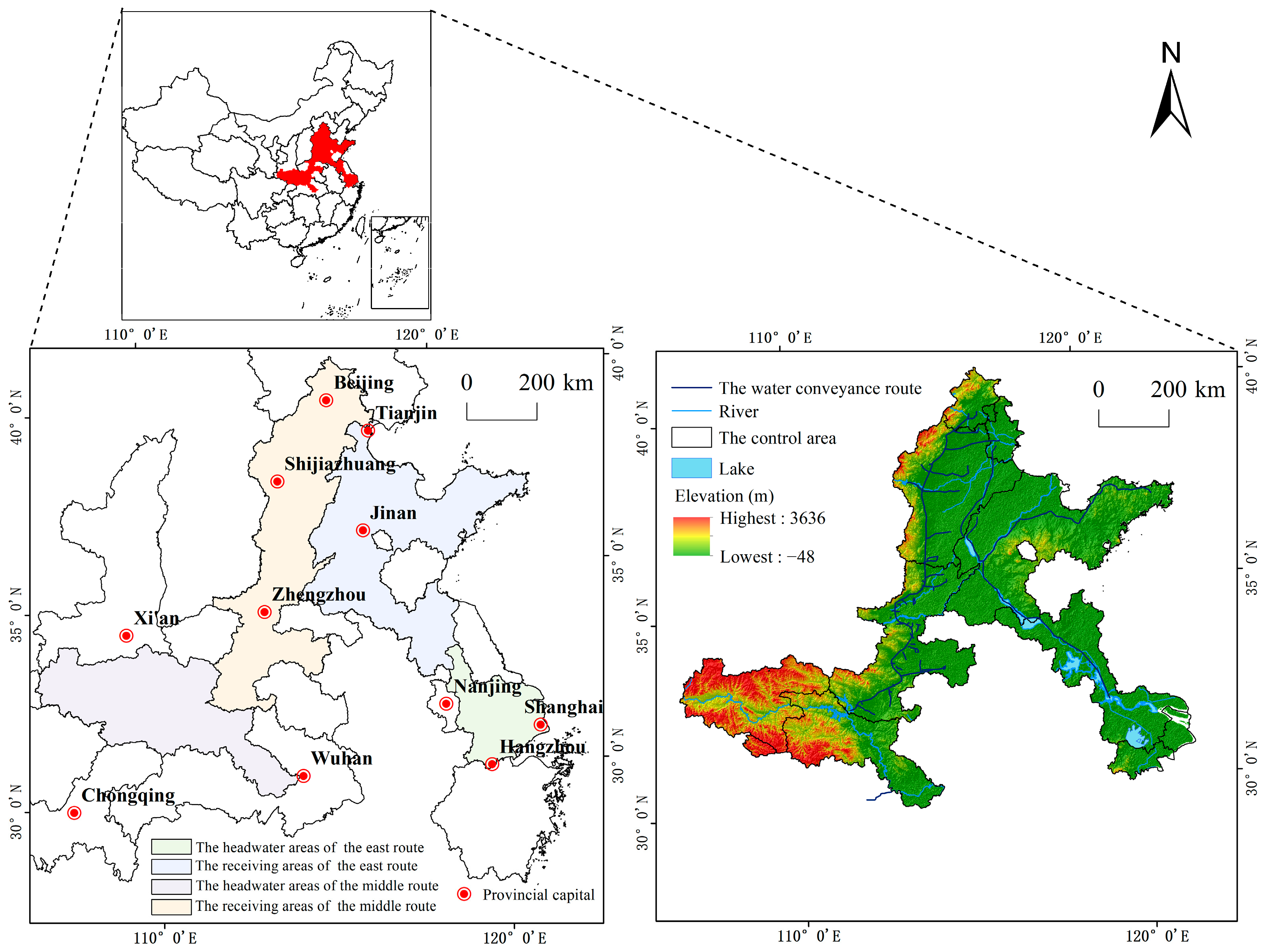
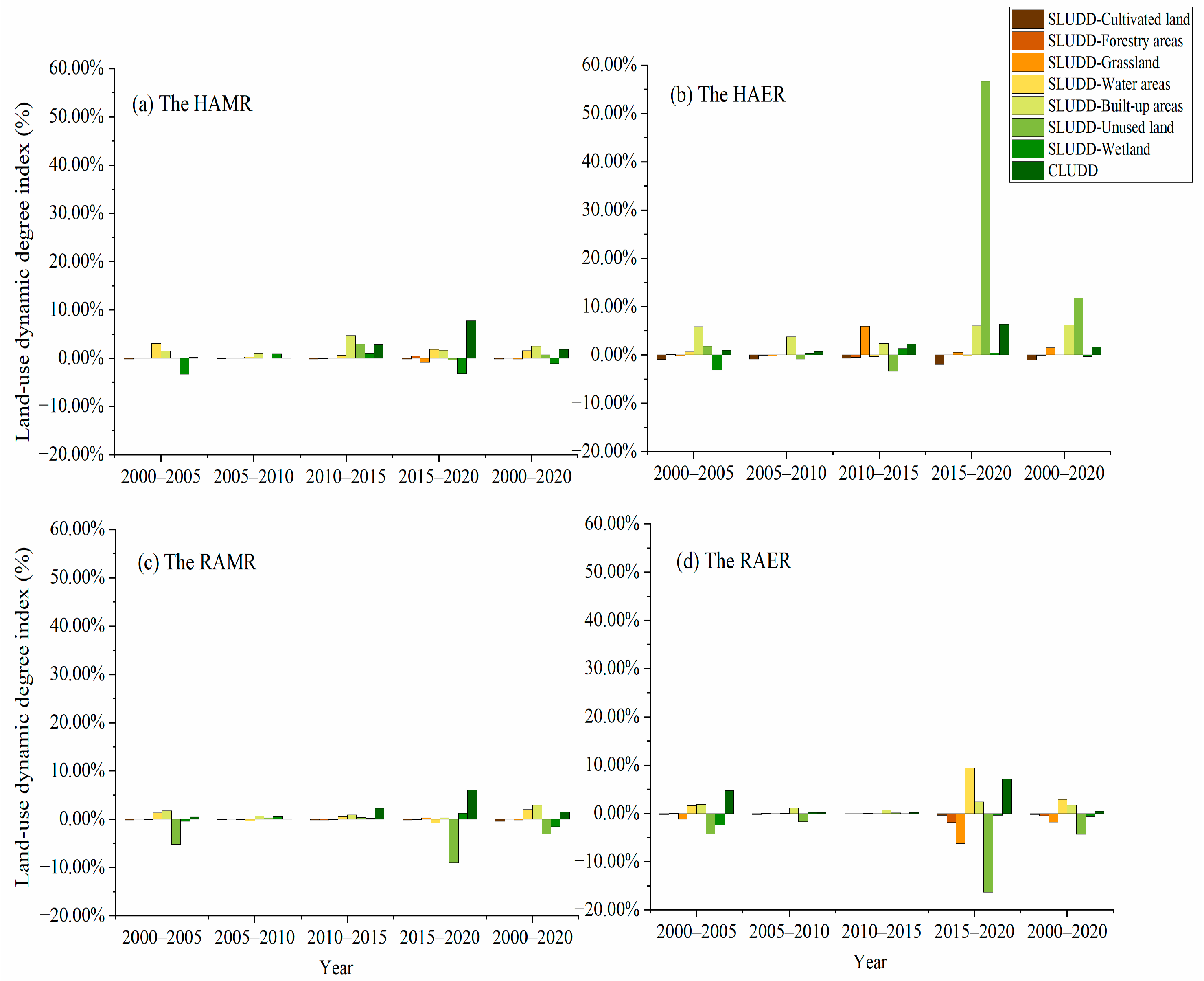
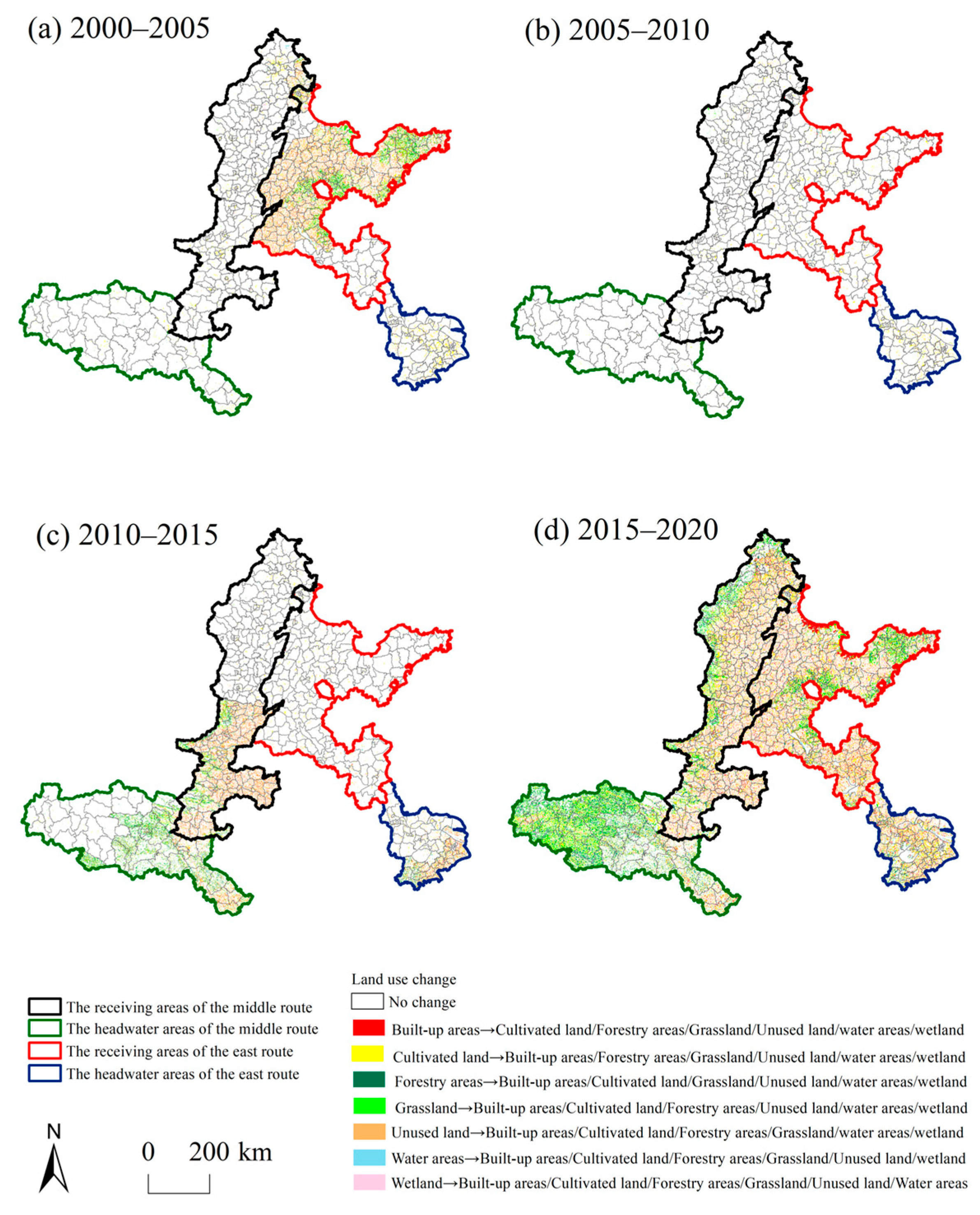
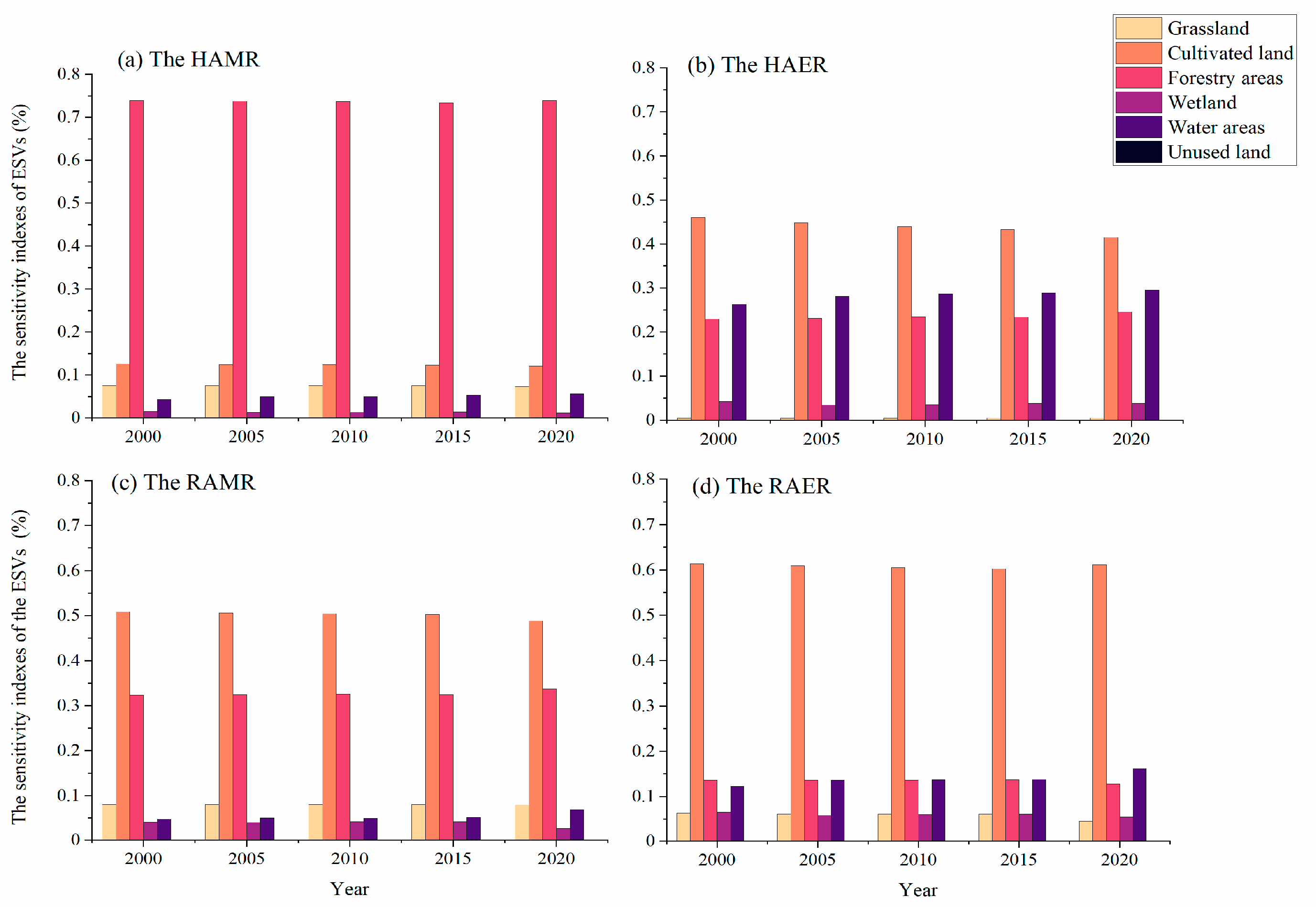
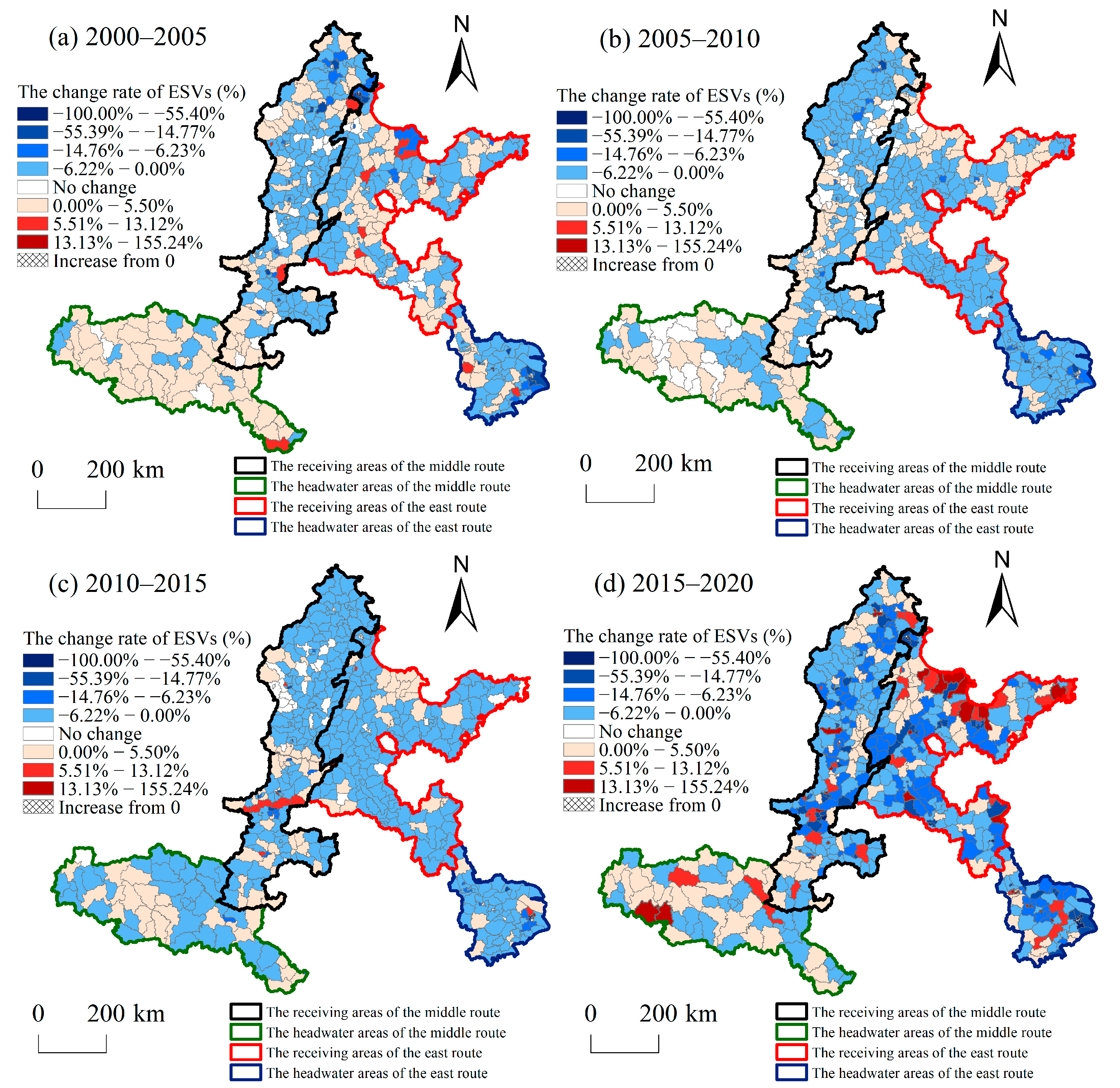
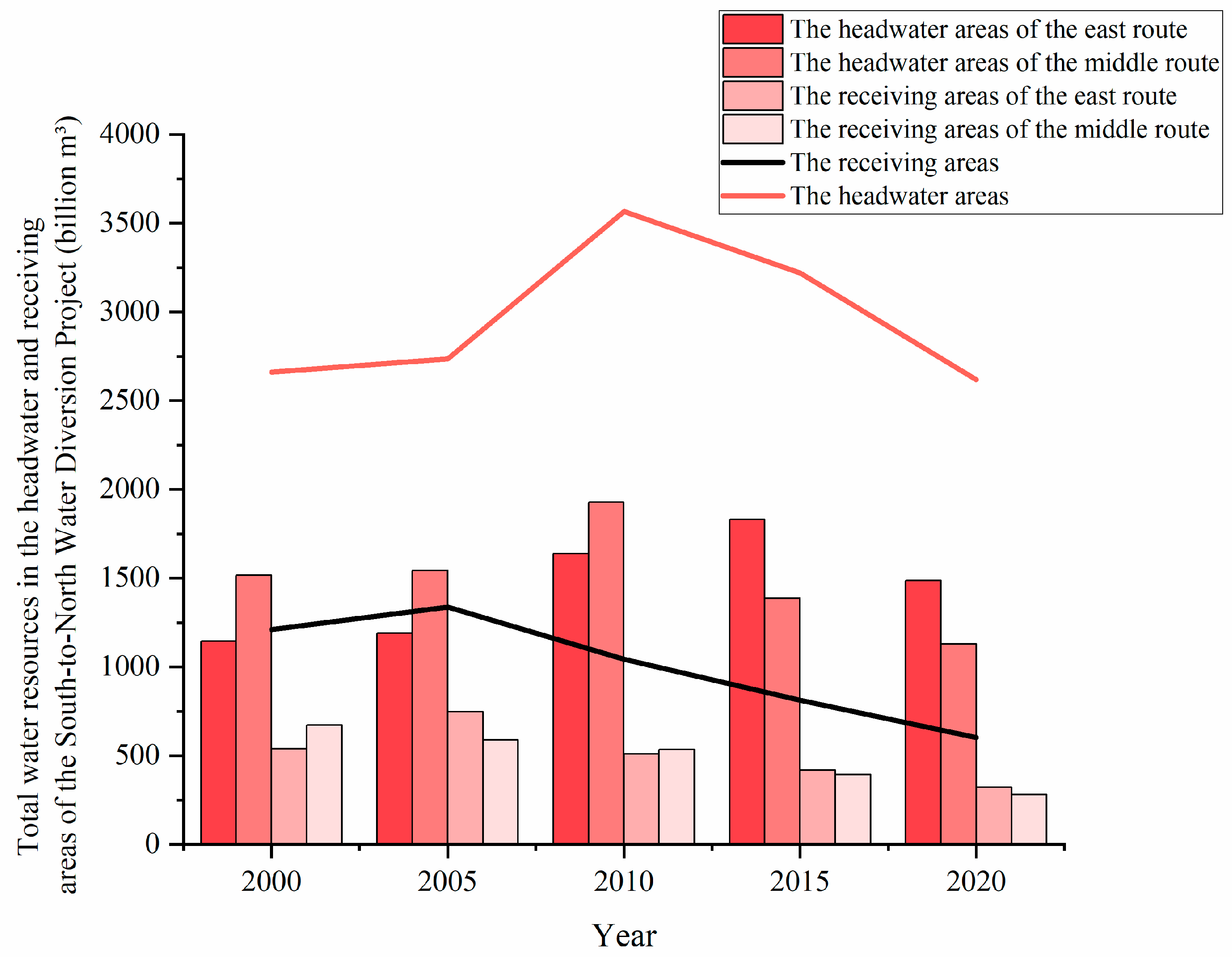
| Region | Beijing | Tianjin | Hebei | Shanghai | Jiangsu | Zhejiang | Shandong | Henan | Hubei | Chongqing | Shaanxi |
|---|---|---|---|---|---|---|---|---|---|---|---|
| The economic value per unit area | 0.043 | 0.045 | 0.036 | 0.030 | 0.046 | 0.050 | 0.050 | 0.052 | 0.050 | 0.027 | 0.018 |
| Type | Grassland | Cultivated Land | Forestry Areas | Wetland | Water Areas | Unused Land | Total |
|---|---|---|---|---|---|---|---|
| 2000 | 7850.93 | 13,077.70 | 76,668.62 | 1615.68 | 4450.45 | 2.02 | 103,665.41 |
| 2005 | 7876.86 | 12,936.56 | 76,693.81 | 1350.77 | 5148.43 | 2.02 | 104,008.46 |
| 2010 | 7876.84 | 12,892.52 | 76,666.47 | 1430.31 | 5215.74 | 2.02 | 104,083.90 |
| 2015 | 7872.68 | 12,772.65 | 76,213.17 | 1524.03 | 5493.00 | 2.24 | 103,877.76 |
| 2020 | 7590.36 | 12,620.25 | 77,290.06 | 1181.49 | 5851.80 | 2.16 | 104,536.12 |
| 2000–2005 | 25.93 | −141.15 | 25.20 | −264.91 | 697.98 | 0 | 343.05 |
| 2005–2010 | −0.02 | −44.04 | −27.35 | 79.54 | 67.31 | 0 | 75.44 |
| 2010–2015 | −4.16 | −119.87 | −453.30 | 93.72 | 277.26 | 0.21 | −206.14 |
| 2015–2020 | −282.33 | −152.40 | 1076.90 | −342.54 | 358.81 | −0.08 | 658.36 |
| 2000–2020 | −260.57 | −457.45 | 621.45 | −434.19 | 1401.35 | 0.14 | 870.71 |
| Type | Grassland | Cultivated Land | Forestry Areas | Wetland | Water Areas | Unused Land | Total |
|---|---|---|---|---|---|---|---|
| 2000 | 133.98 | 14,548.46 | 7256.22 | 1350.90 | 8322.02 | 0.94 | 31,612.51 |
| 2005 | 131.40 | 14,019.05 | 7250.11 | 1098.62 | 8824.01 | 1.07 | 31,324.26 |
| 2010 | 130.62 | 13,564.63 | 7245.27 | 1104.11 | 8863.91 | 1.00 | 30,909.54 |
| 2015 | 153.04 | 13,197.00 | 7124.97 | 1158.94 | 8817.29 | 0.91 | 30,452.14 |
| 2020 | 147.65 | 12,211.38 | 7234.07 | 1126.52 | 8671.46 | 3.63 | 29,394.71 |
| 2000–2005 | −2.58 | −529.40 | −6.11 | −252.28 | 501.99 | 0.13 | −288.26 |
| 2005–2010 | −0.78 | −454.43 | −4.83 | 5.49 | 39.90 | −0.07 | −414.72 |
| 2010–2015 | 22.42 | −367.63 | −120.30 | 54.83 | −46.62 | −0.09 | −457.39 |
| 2015–2020 | −5.39 | −985.62 | 109.10 | −32.42 | −145.83 | 2.72 | −1057.43 |
| 2000–2020 | 13.67 | −2337.08 | −22.15 | −224.38 | 349.44 | 2.69 | −2217.80 |
| Type | Grassland | Cultivated Land | Forestry Areas | Wetland | Water Areas | Unused Land | Total |
|---|---|---|---|---|---|---|---|
| 2000 | 7559.31 | 47,881.69 | 30,472.08 | 3835.83 | 4438.59 | 4.11 | 94,191.60 |
| 2005 | 7533.45 | 47,471.46 | 30,455.31 | 3764.00 | 4669.98 | 2.91 | 93,897.11 |
| 2010 | 7508.15 | 47,288.55 | 30,464.16 | 3880.45 | 4590.50 | 2.94 | 93,734.75 |
| 2015 | 7509.79 | 47,014.94 | 30,382.31 | 3928.20 | 4772.70 | 3.06 | 93,610.99 |
| 2020 | 7283.87 | 44,660.90 | 30,843.06 | 2419.46 | 6238.02 | 1.31 | 91,446.62 |
| 2000–2005 | −25.86 | −410.23 | −16.77 | −71.83 | 231.40 | −1.20 | −294.49 |
| 2005–2010 | −25.30 | −182.91 | 8.85 | 116.45 | −79.49 | 0.03 | −162.36 |
| 2010–2015 | 1.64 | −273.62 | −81.85 | 47.75 | 182.20 | 0.12 | −123.76 |
| 2015–2020 | −225.93 | −2354.04 | 460.75 | −1508.74 | 1465.32 | −1.75 | −2164.38 |
| 2000–2020 | −275.44 | −3220.80 | 370.98 | −1416.36 | 1799.44 | −2.80 | −2744.98 |
| Type | Grassland | Cultivated Land | Forestry Areas | Wetland | Water Areas | Unused Land | Total |
|---|---|---|---|---|---|---|---|
| 2000 | 5998.67 | 58,407.88 | 12,963.31 | 6192.02 | 11,648.09 | 87.45 | 95,297.42 |
| 2005 | 5768.51 | 57,776.81 | 12,903.06 | 5495.50 | 12,901.90 | 77.48 | 94,923.26 |
| 2010 | 5748.78 | 57,248.88 | 12,907.52 | 5688.91 | 12,989.27 | 75.27 | 94,658.63 |
| 2015 | 5752.91 | 56,837.75 | 12,898.97 | 5725.95 | 13,017.33 | 75.22 | 94,308.13 |
| 2020 | 4123.02 | 56,317.97 | 11,761.98 | 5019.76 | 14,899.99 | 14.38 | 92,137.11 |
| 2000–2005 | −230.17 | −631.06 | −60.25 | −696.53 | 1253.81 | −9.97 | −374.16 |
| 2005–2010 | −19.72 | −527.93 | 4.46 | 193.41 | 87.37 | −2.21 | −264.63 |
| 2010–2015 | 4.13 | −411.13 | −8.55 | 37.04 | 28.06 | −0.06 | −350.50 |
| 2015–2020 | −1629.89 | −519.78 | −1136.99 | −706.19 | 1882.67 | −60.83 | −2171.02 |
| 2000–2020 | −1875.65 | −2089.90 | −1201.33 | −1172.26 | 3251.90 | −73.07 | −3160.31 |
Disclaimer/Publisher’s Note: The statements, opinions and data contained in all publications are solely those of the individual author(s) and contributor(s) and not of MDPI and/or the editor(s). MDPI and/or the editor(s) disclaim responsibility for any injury to people or property resulting from any ideas, methods, instructions or products referred to in the content. |
© 2023 by the authors. Licensee MDPI, Basel, Switzerland. This article is an open access article distributed under the terms and conditions of the Creative Commons Attribution (CC BY) license (https://creativecommons.org/licenses/by/4.0/).
Share and Cite
Zhuge, J.; Zeng, J.; Chen, W.; Zhang, C. Impacts of Land-Use Change on Ecosystem Services Value in the South-to-North Water Diversion Project, China. Int. J. Environ. Res. Public Health 2023, 20, 5069. https://doi.org/10.3390/ijerph20065069
Zhuge J, Zeng J, Chen W, Zhang C. Impacts of Land-Use Change on Ecosystem Services Value in the South-to-North Water Diversion Project, China. International Journal of Environmental Research and Public Health. 2023; 20(6):5069. https://doi.org/10.3390/ijerph20065069
Chicago/Turabian StyleZhuge, Jing, Jie Zeng, Wanxu Chen, and Chi Zhang. 2023. "Impacts of Land-Use Change on Ecosystem Services Value in the South-to-North Water Diversion Project, China" International Journal of Environmental Research and Public Health 20, no. 6: 5069. https://doi.org/10.3390/ijerph20065069
APA StyleZhuge, J., Zeng, J., Chen, W., & Zhang, C. (2023). Impacts of Land-Use Change on Ecosystem Services Value in the South-to-North Water Diversion Project, China. International Journal of Environmental Research and Public Health, 20(6), 5069. https://doi.org/10.3390/ijerph20065069








